Protecting a Neighborhood Bald Eagle Nest
With good reason, Alaska usually comes to mind at any mention of Bald Eagles. Yet, it surprises some people to learn that, in the lower 48 states, breeding Bald Eagles are most numerous in Florida and Minnesota. In 1990 there were 535 breeding pairs in Florida, and 437 in Minnesota. The number of Florida breeding pairs rebounded rapidly to 1,102 pairs in 2001, then plateaued at 1,133 in 2005. In the meantime, Minnesota's population climbed slowly at first, to 681 pairs in 2001, then shot up to 1,312 pairs in 2005, surpassing the Florida population.
This US Fish and Wildlife Service graph illustrates the recovery of breeding Bald Eagles in the lower 48 states since DDT was banned in the early 1970s:

In an earlier post, I described why the numbers of Bald Eagles in the more northern of the lower 48 states increase during summer and early autumn, due not only to newly fledged eaglets, but to the influx of more southern eagles. The Florida birds perform an interesting "reverse" northward migration after the breeding season. It is hypothesized that this contrary behavior is caused by another sort of "migration," namely the vertical movement of the eagles' main food source.
As Florida's lakes heat up, the fish seek cooler temperatures in deeper water. Radio tagging of Florida eagles has shown that many follow the cooler water into the northeastern coastal states. Chesapeake Bay is a popular summer and fall gathering place for the Florida population. Immature birds tend to wander more widely than adults, with some even ending up in Canada. Conversely, North America's northernmost Bald Eagles move south with the approach of winter, seeking open water as the larger lakes and rivers freeze up.
Alaskan eagles are, on average, heavier than those in Florida and have longer wings. I photographed this one in Soldotna, Alaska, along the Kenai River:
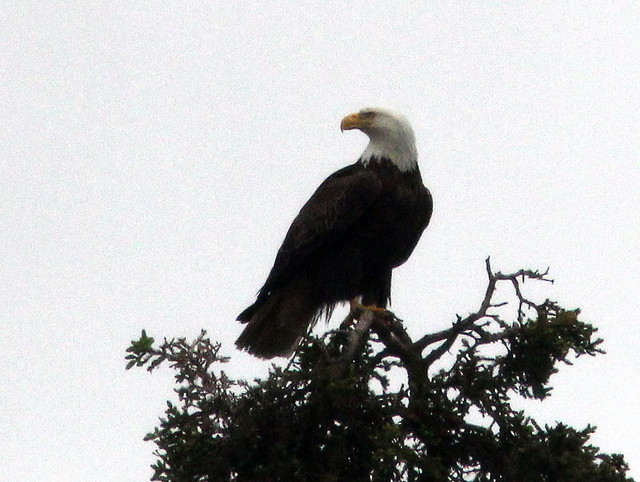
We have a particular interest in Bald Eagles, as we have been involved in protecting a recently discovered nest in our south Florida neighborhood. I served on the Pembroke Pines Mayor's Bald Eagle Sanctuary Steering Committee. During the first week of October, 2011, Mary Lou and I were pleased to see that both members of the pair had returned to the nest:
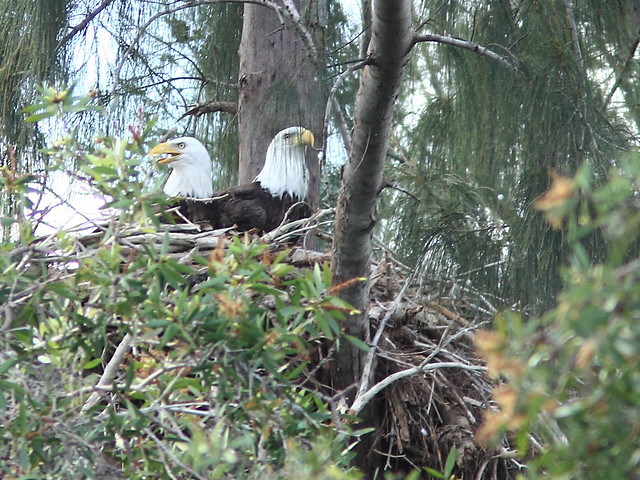
They were already rearranging the nest materials:
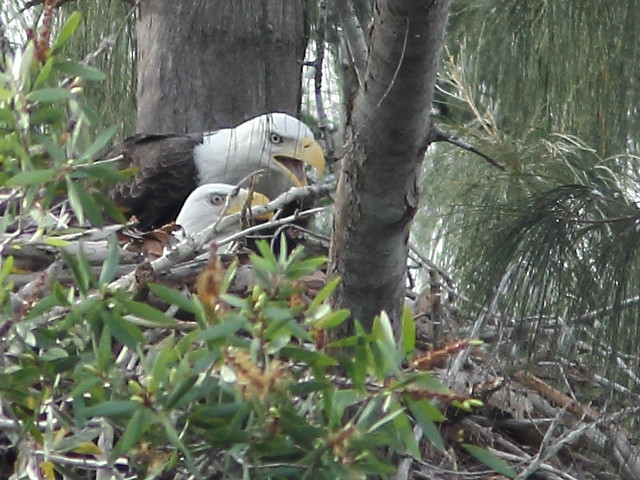
On October 12, 2011, I photographed one of the pair at sunrise, flying from the nest area in the general direction of the largest lake in our subdivision:
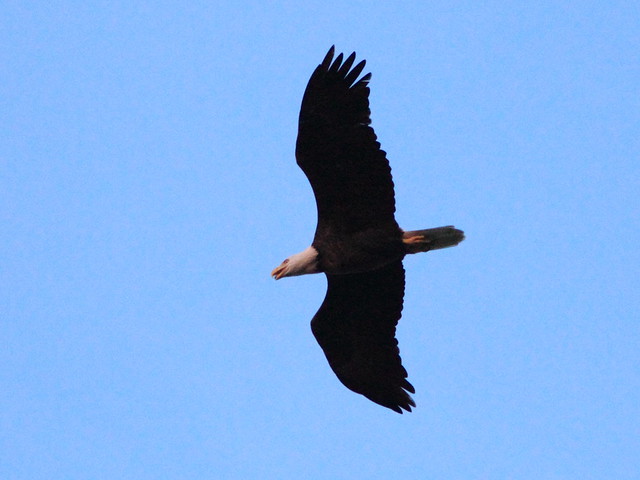
On October 16, 2011, the female was sitting high on the nest...
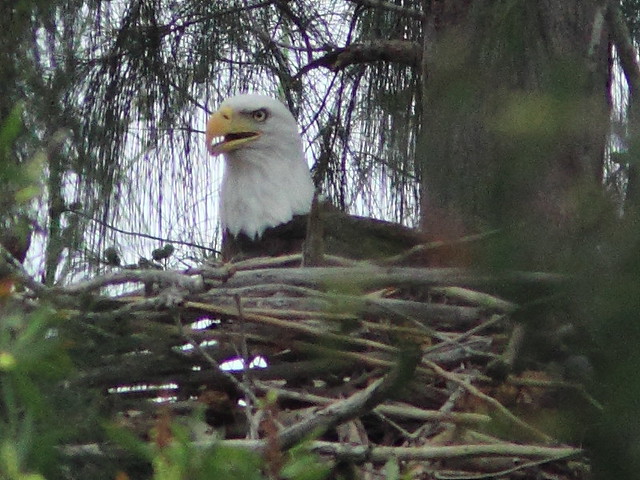
...while her mate (judging by its slimmer build and slightly smaller size) roosted in a nearby Australian Pine:
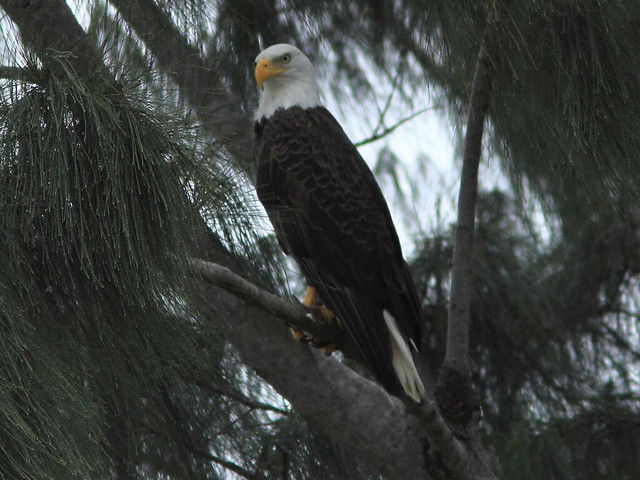
We first became aware of the local pair of eagles on December 4, 2007, when I photographed them mating on the rooftop of a house just across the lake from our home:
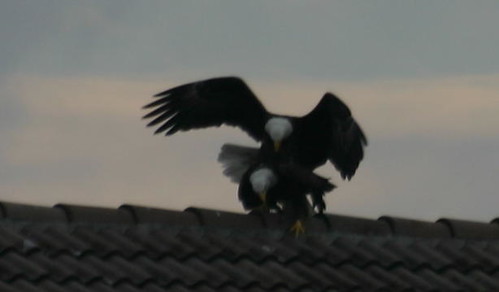
As there had not been a record of an active Bald Eagle nest in Broward County since several years before DDT was abolished in the early 1970s, I reported the sighting on the Tropical Audubon Society's Web page, and birders in neighboring Pembroke Pines had a general idea of where they might be breeding. In March, 2008, Kelly Smith, a local middle school teacher found the nest, located only about 150 feet from a busy boulevard. It contained one nearly full-grown eaglet.
This photo of "P. Piney One" was taken by Kelly Smith on March 15, 2008 and is reproduced here with her permission (click on box to view if not visible here):
This pair of eagles has returned to the same nest each year, successfully raising and fledging two chicks in 2009, three in 2010, two more in 2011, a single chick in 2012, two in 2013 (one of these eaglets disappeared at about 15 days of age), two more the next year (both survived), but they did not breed in 2014. The story of their nesting failure and the interesting events of the 2015-2016 season are detailed towards the end of this post.
The nest is about 50 feet high in an exotic Australian Pine tree with smaller trees blocking most of the view, so we only get distant looks.
On December 11, 2008, the beginning of their first full breeding season under our observation, both adults are shown sitting on the nest, only two days before the first of two eggs was laid::

Local middle school students conducted a nationwide poll that chose names for the two eaglets, “Hope” and "Justice:” They hatched on January 15,2009. Here they are,
squabbling with each other at exactly one month of age. Hope, the older and larger, is on the left:
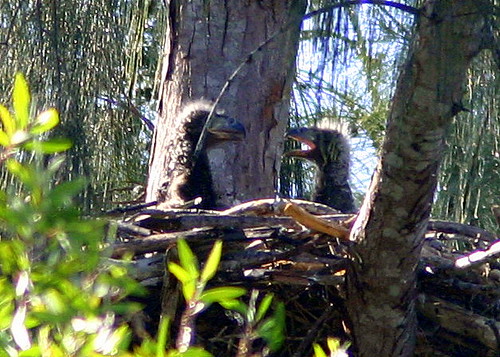
The eagle nest attracted a great deal of attention, and crowds of up to 100 people came to see the antics of the eaglets, causing traffic hazards as they stopped on the roadway and parked illegally.
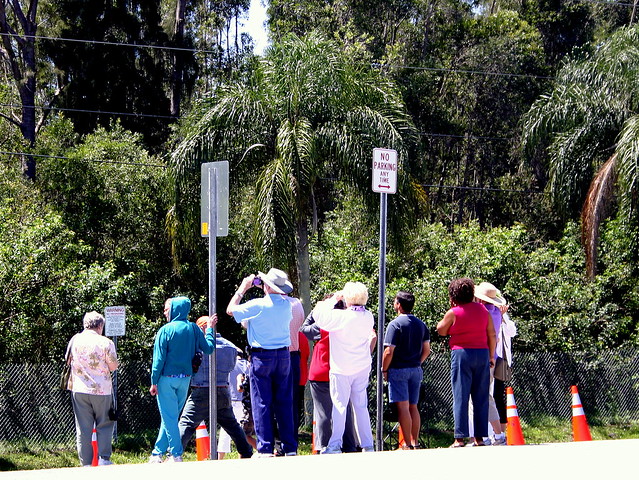
The Mayor took an interest in the nest, which is located on City of Pembroke Pines property, and he announced his intention to declare the site a City Bald Eagle Sanctuary, and took measures to protect both the eagles and observers.The City amended its planning documents which paved the way for an ordinance that provides extra safeguards against disturbance of any eagle nest in the city. During the summer of 2011, major resurfacing of the roadway and construction of a sidewalk were suspended in the area of the nest during the eagles' breeding season (May 15 - October 1).
I photographed these three eaglets on March 2, 2010. The Middle School students' poll resulted in them being named Chance, Lucky and Courage. All three fledged successfully:

The eagles returned in October, 2010 to refurbish the nest, and eggs were laid around December 11. ( * See end note about how we estimate the time of egg laying and hatching). On January 23, 2011 at the age of about 9 days, this chick was first seen, peering over the nest rim:
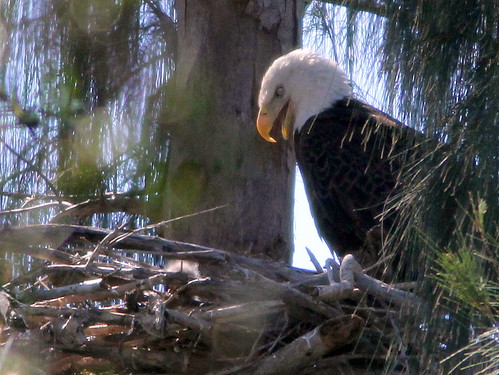
Here, it waits as its parent tears off a bit of food. A younger sibling was not yet visible from the ground:
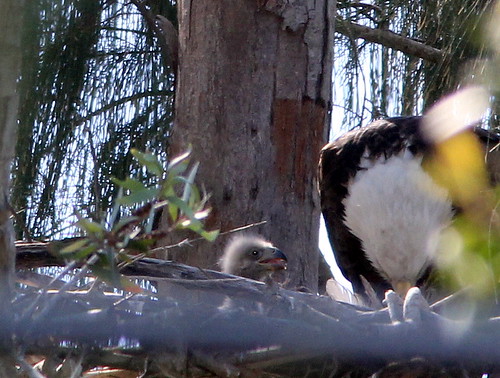
The Parent eagle feeds the chick :
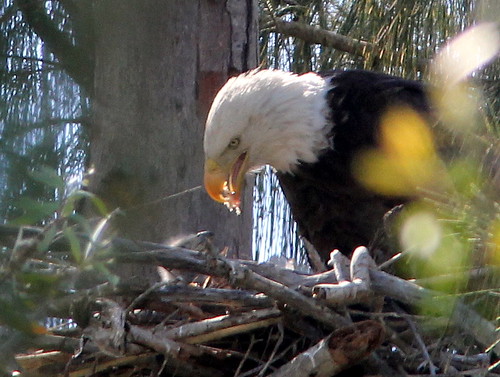
This was about as good a view we could get from 150 feet. Vegetation now makes viewing much more difficult. Plans for a nest camera have not materialized:
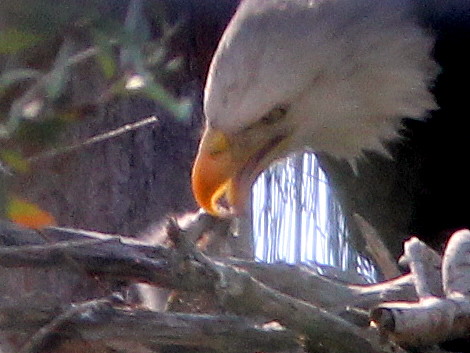
Here is the older of the two eaglets, on February 3, 2011. Much of her natal down has already disappeared:
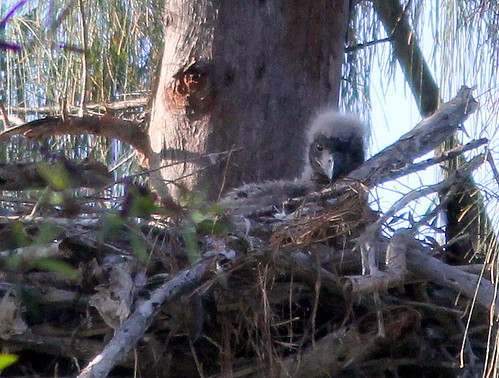
At one month old, on February 15, 2011, the down had been reduced to a fuzzy cap:
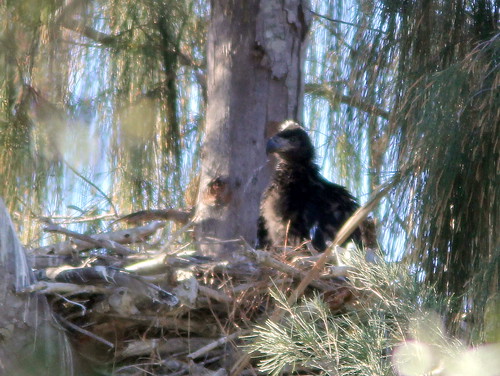
Less than two weeks later, on February 27, 2011, the eaglets looked almost as large as adults. We called them "P. Piney Seven & Eight." Bald Eagles exhibit sexual dimorphism that starts when they are nestlings, with the females usually considerably larger than males.
P Piney 7 is the larger and was presumed to be a female:
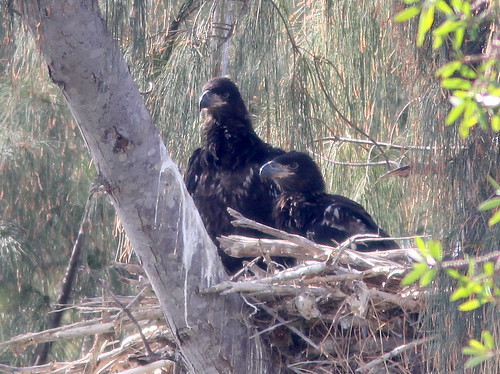
At two and a half months of age on March 23, 2011 they were exercising their wings, preparing for their first flight, which usually occurs when they are between 10 and 12 weeks old.
PP7, on the right, has more white underneath than her younger brother:
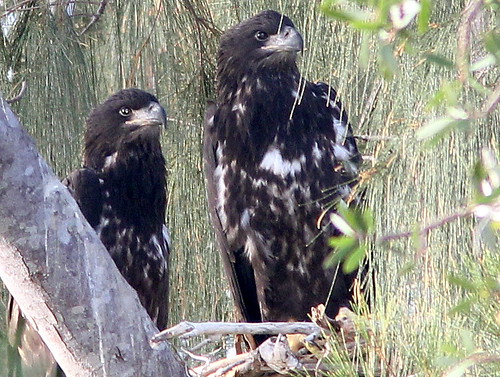
On March 30, 2011, we found PP8 alone in the nest; PP7 had flown off, but returned within three days to be fed:
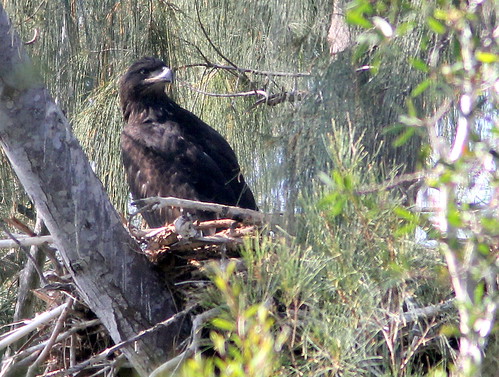
On March 30, PP8 was "helicoptering," hovering in place up to a foot off the ground:
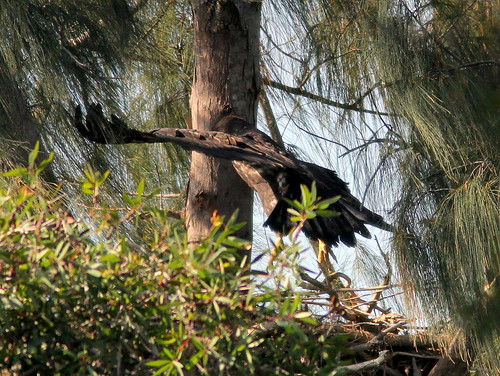
Here, on April 3, 2011, my last shot of PP7 shows her roosting in a tree next to the nest. PP8 was flying back and forth on branches in the nest tree:
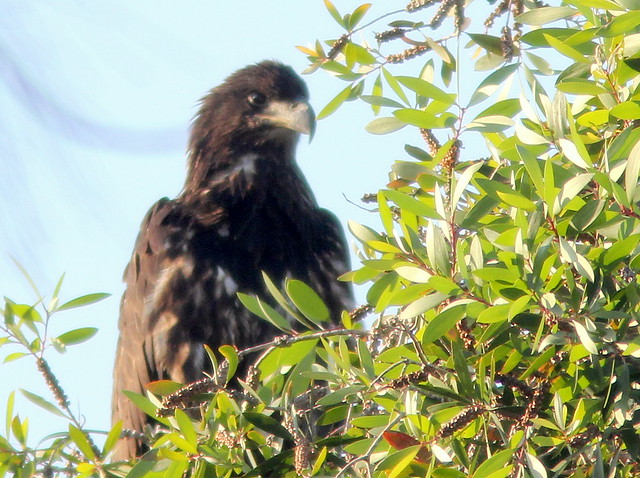
That year, both P Piney 7 and 8 fledged successfully. In the next (2011-2012) only one eaglet was known to have hatched, although there was a possible sighting of a very small second sibling. Unfortunately, P Piney 9 suddenly disappeared at about 9-10 weeks old, when nearly old enough to fly independently. It may have fledged prematurely but was never seen again.
Pride feeding P Piney 9 on FEB 17, 2012:
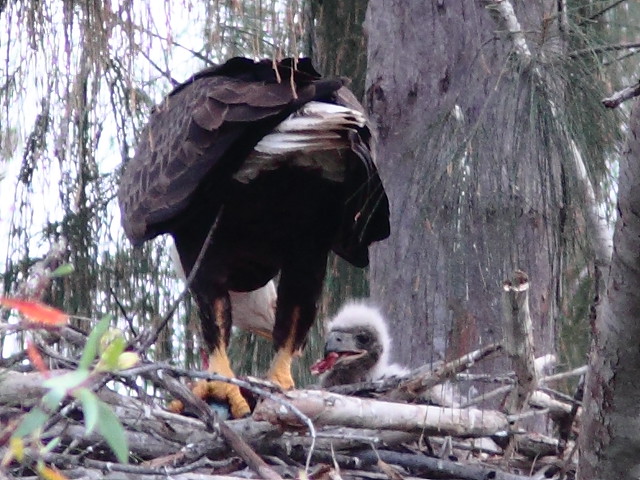
The next breeding season (2012-2013) produced two eaglets. Both fledged but the second (P Piney 11) disappeared from the nest 4 days later and presumably was killed during or just after its first flight. Ground search for this eaglet or its remains was not successful. The first flight is known to be associated with a high mortality rate.
Here is P Piney 10 in March, 2013:
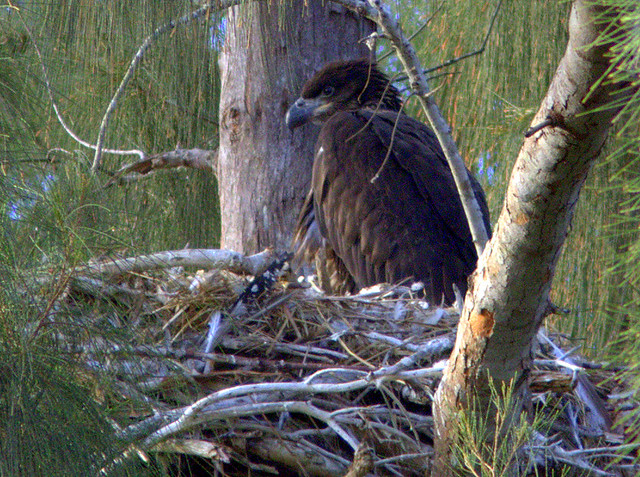
Breeding season 2013-2014 was a great success. Two eaglets (named Honor and Glory) both fledged in early April, 2014.
Honor and Glory beg to be fed by their mother (Joy) on March 30, 2014:
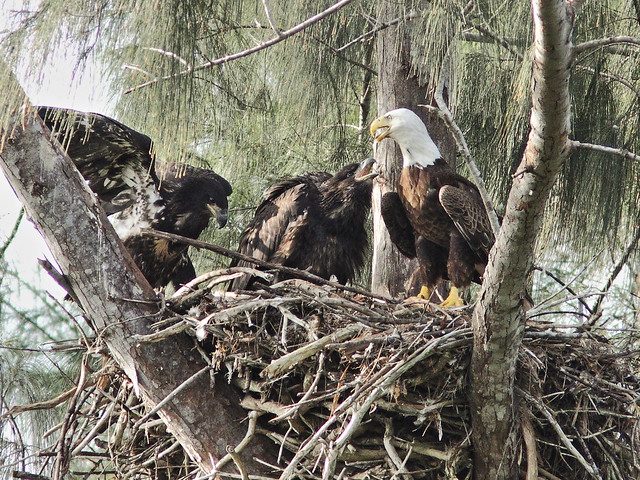
However, in October 2014, the original female parent (Joy) suddenly disappeared. Her mate (Pride) found a new mate (Jewel) in December. The pair bonded and mated but failed to breed in the 2014-2015 season, possibly because Jewel was only 4 years old and inexperienced.
Pride "introduced" us to his new bride, Jewel on December 7, 2014. She shows rather extensive dark feathers in her tail, having not yet molted into full adult plumage, which is usually completed after 4 years of age:
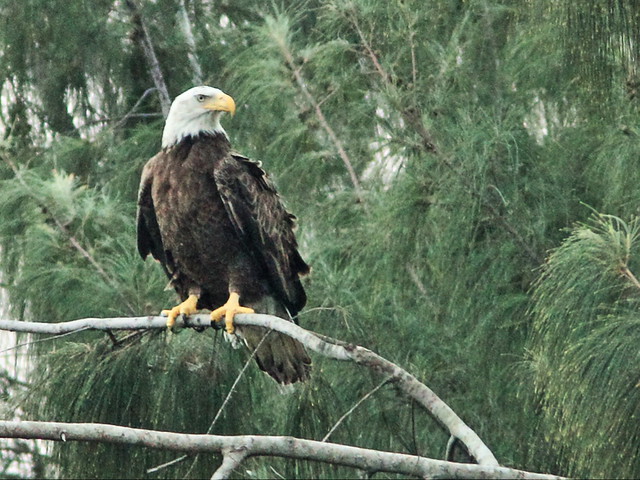
This photo, taken on March 12, 2015, provides a comparison between the heads of Jewel in nearly full adult plumage, (foreground) and Pride. Jewel is overall larger and her head appears more massive and rounded, while Pride's forehed slopes almost in line with the top of his beak. The angle (gape) of the female's beak usually extends at least to a point below the center of her eye, while that of the male is more aligned with the front edge of his eye:
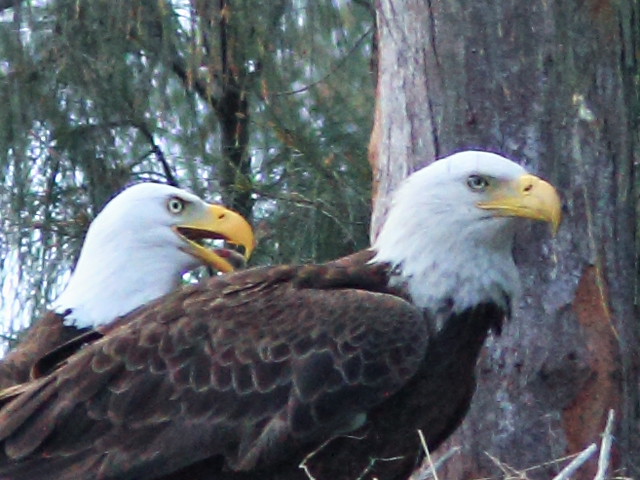
Here is Jewel, probably 4 1/2 years old, on October 24, 2015 in fully adult plumage except for a few dark feathers in her head and tail. She was bringing in new sticks:
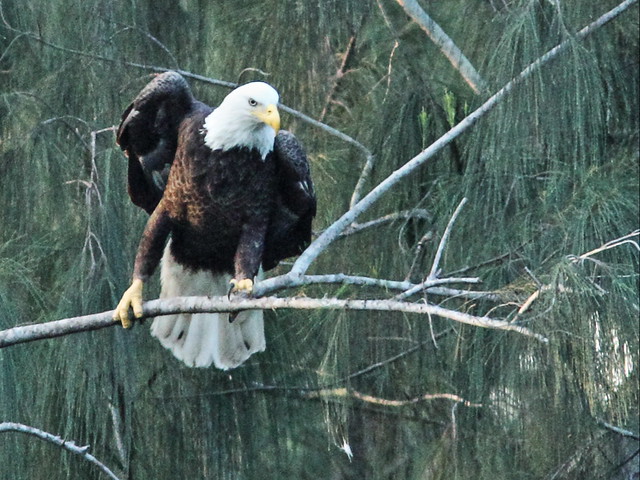
Pride and Jewel (in nest) adding and rearranging sticks on October 24, 2015:
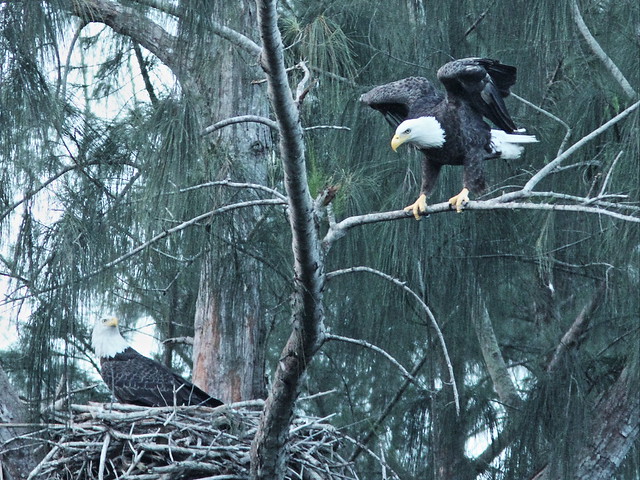
Disaster struck the next season (2015-16). Joy hatched at least one eaglet (P Piney 14) in mid-January 2016, but a severe storm damaged the nest and the little chick was never seen again. At first we thought that the parents had abandoned the nest, but they returned to produce a second brood. This is a very unusual event, but because of the widespread stormy weather several other south Florida eagle pairs also suffered similar losses and laid eggs a second time.
Two eaglets hatched in mid-March, 2016. This was my first photo of the younger and smaller one, P Piney 16 on April 2, 2016:
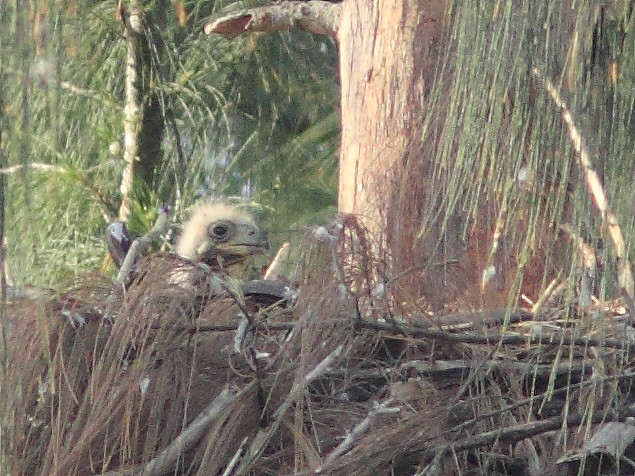
The older nestling (Spirit) grew very rapidly as is commonly seen in female eaglets. She towered over P Piney 16, out-competed for food and attacked him repeatedly. He disappeared or was killed by Spirit on April 11, 2016.
Spirit is on the left in this photo taken on April 4, 2016, a week before P Piney 16 suffered a particularly vicious assault by his sibling:
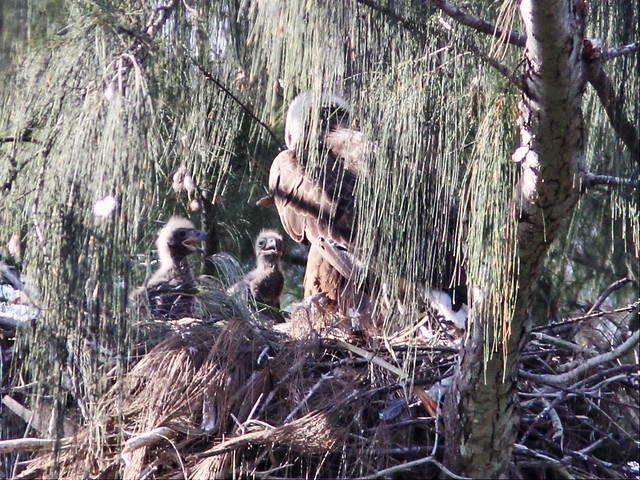
Almost ready to fly, Spirit is larger than the adult male parent (Pride) on May 27, 2016:
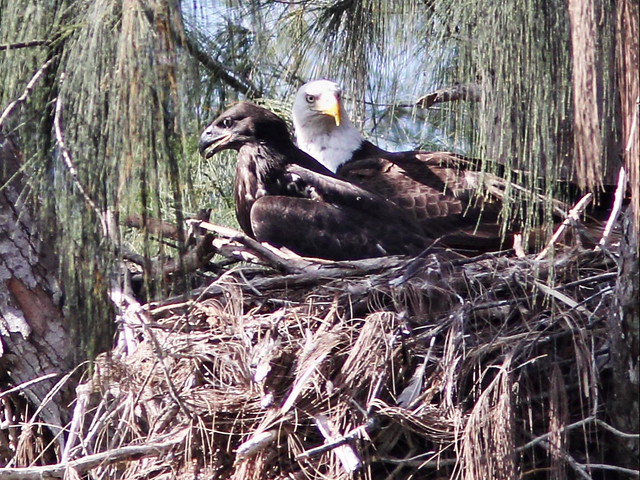
Spirit fledged in mid-June and was observed foraging on her own into mid-August, 2016. Here is Spirit on JULY 17, 2016:
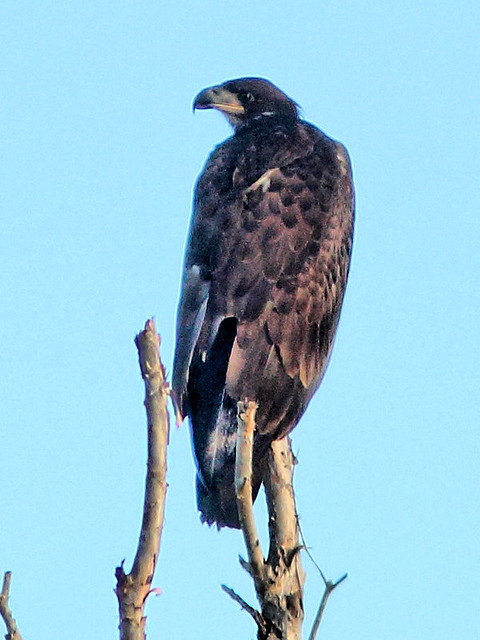
During the 2016-17 breeding season the pair successfully raised two eaglets, which fledged on April 28 and May 6, 2017. Here are the two eaglets being fed, April 14:
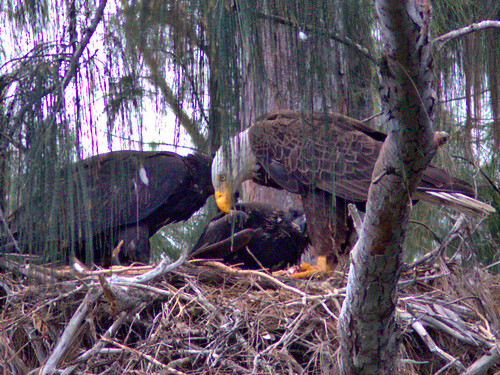
Juvenile returned to be fed on the nest, June 8, 2017:
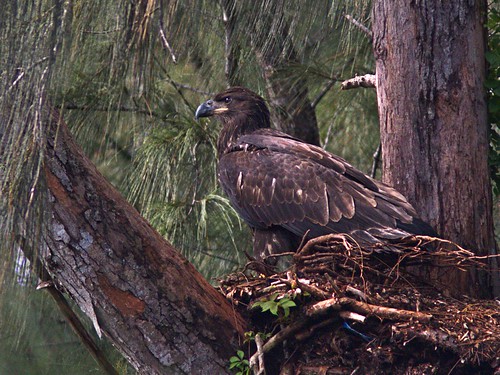
The 2017-18 breeding season was another success for the local pair of Bald Eagles. By mid-October 2017 they worked together to reconstruct their nest:

Egg-laying commenced during the second week of December and by mid-January 2018 the parents were observed feeding unseen eaglets in two positions. however, photos near the end of January revealed only one eaglet, so mortality of the second chick was presumed.
The eaglet, called P Piney 19 (the 19th known hatchling produced at this nest) at 26 days of age on February 5:
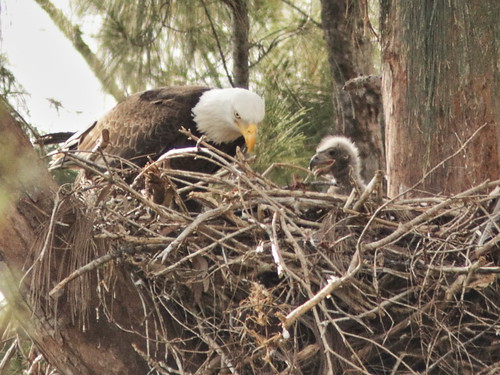
The eaglet, judged by its large size to be a female, fledged on April 2 and returned to the nest to be fed. She was free-flying on April 11, and often foraged with one of her parents:
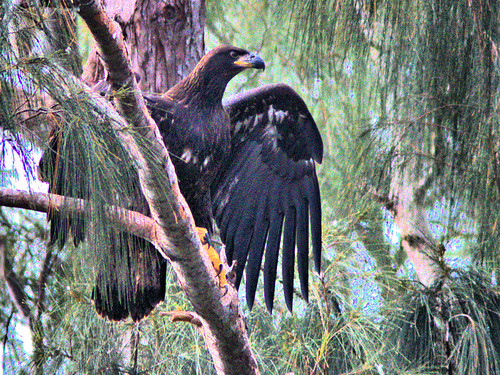
"P Piney 19" lingered near the nest longer than usual and was last seen flying over the local wetlands with one of the adults on July 23, 2018:
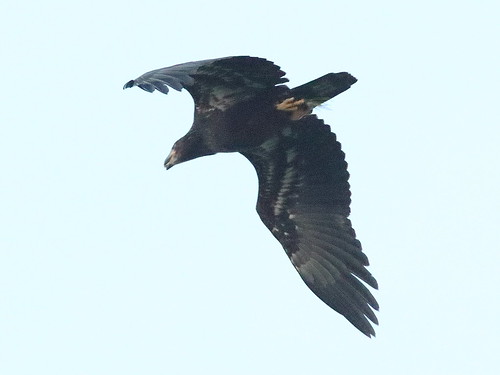
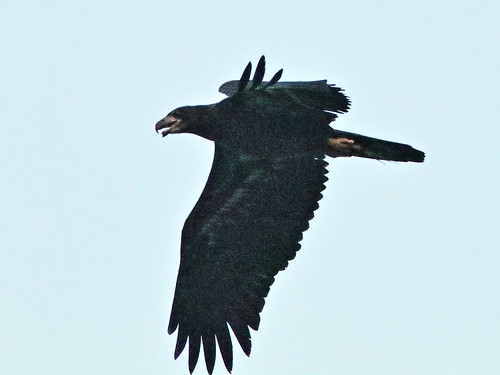
Interesting-- the eaglet was carrying some grass in her talons:
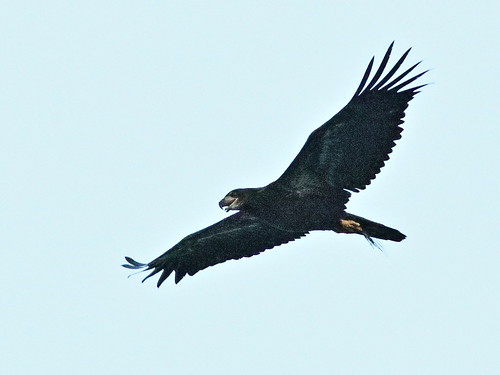
Now the adults have returned to begin a new nesting cycle. Here they are, roosting in a tree near the nest on October 7, 2018. The male (Pride) is to the left, while his mate (Jewel) is perched higher up. Note that the male's smaller body is more tapered towards the tail end while Jewel is much more filled out "below the waist.:"
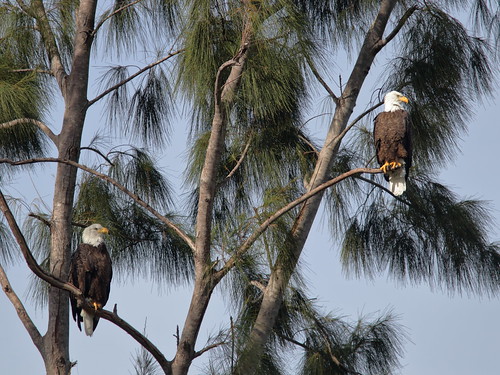
The pair spent much time preening:
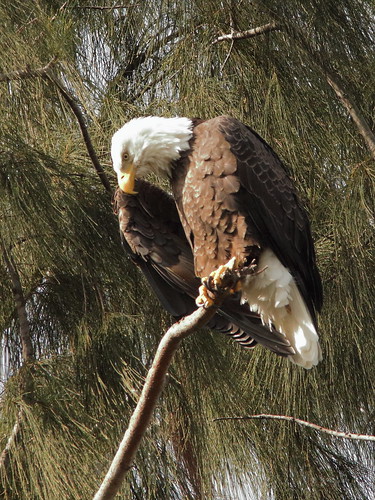
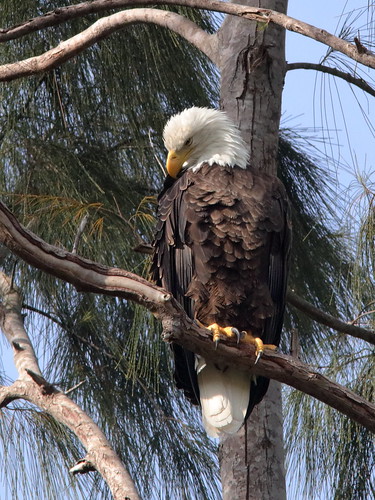
When Pride finished preening he got all ruffled up:
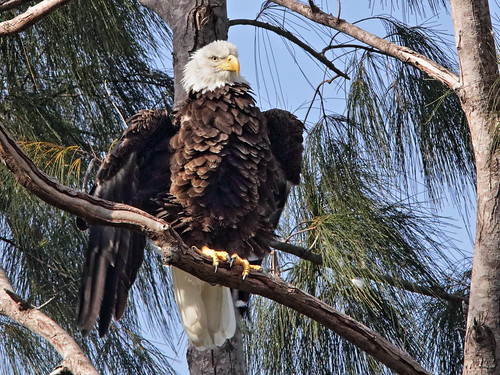
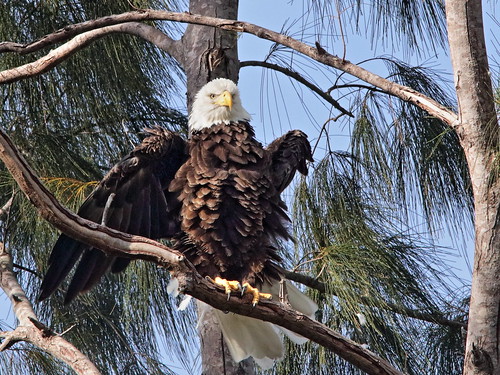
A closeup of Jewel's talons shows the elongated hind toe (hallux), characteristic of the female:

Jewel is checking out something on the ground below:
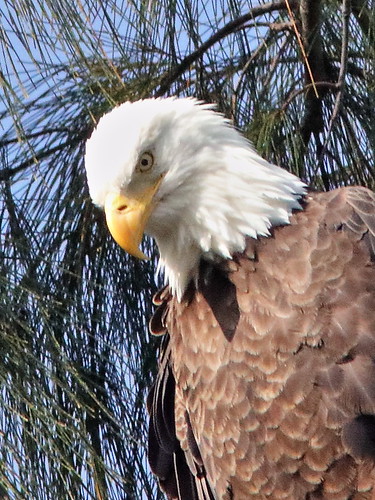
The nest appeared to have some new sticks added:
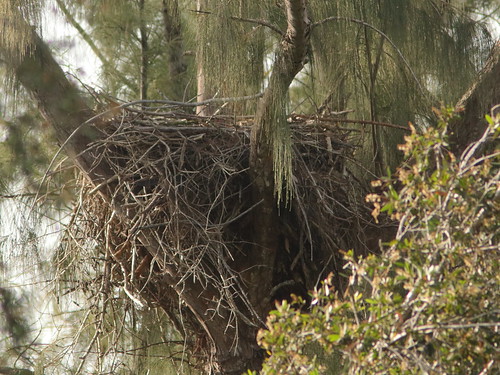
The pair worked on the nest into mid-November, and courtship activity increased. On November 17, 2018 they copulated successfully.
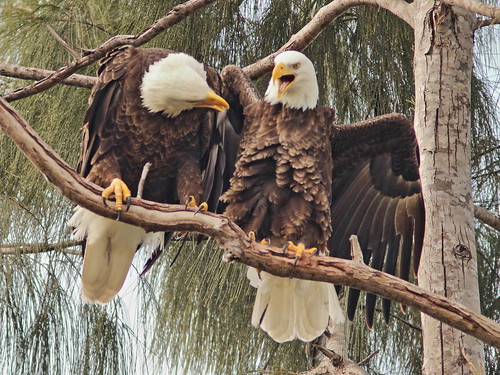

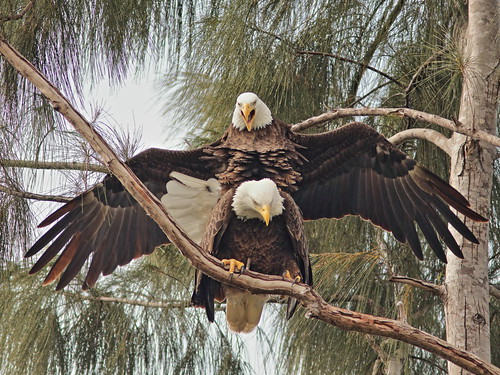
Their first egg was laid about December 5, and it hatched around January 10, 2019.* Two eaglets were first seen on January 231, 2019:

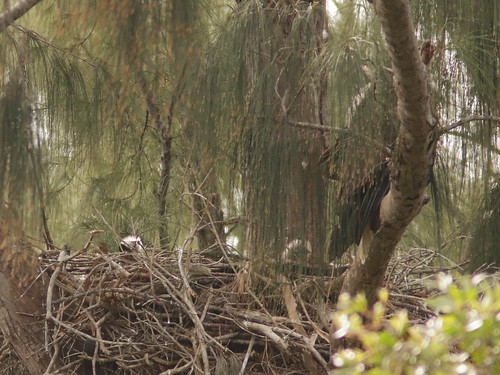
Here are the two eaglets, from left to right, the male (P Piney 22) and female (P Piney 21) about 11 weeks old, on March 16, 2019:

Both fledged on successive days just one week later. They immediately returned to the nest to be fed:
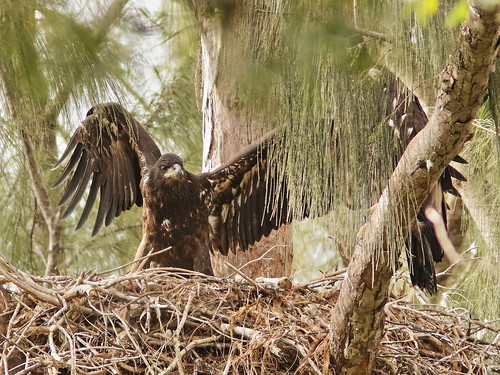
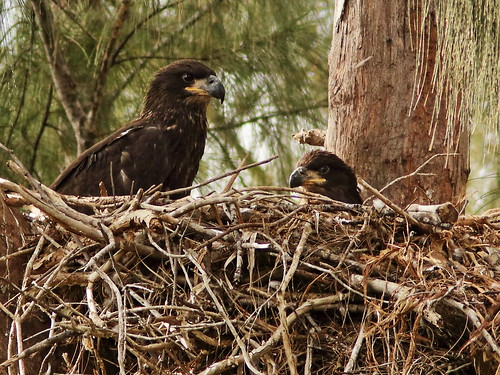
There was a chaotic food drop on April 14, when the male parent flew in with unidentified prey, but both eaglets attacked fiercely, driving the adult back: .

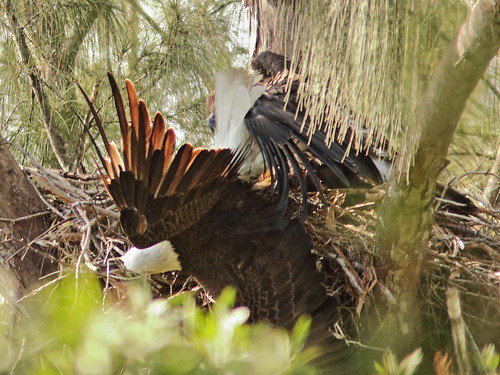

The older eaglet then crouched down over the prey and spread her wings to guard it while the younger eaglet settled down behind her:

By mid-May, both youngsters had migrated away, probably to find cooler water to the north, where fish tend to be nearer the surface and are easier to catch.
The 2019-2020 breeding season succeeded despite a tragedy. The Pembroke Pines Bald Eagles lost their first brood when windstorms disrupted their nest in early January, 2020. Pride and Jewel had started the breeding season by restoring their usual nest together, starting the last week of September, 2019. Jewel is to the right in these photos:
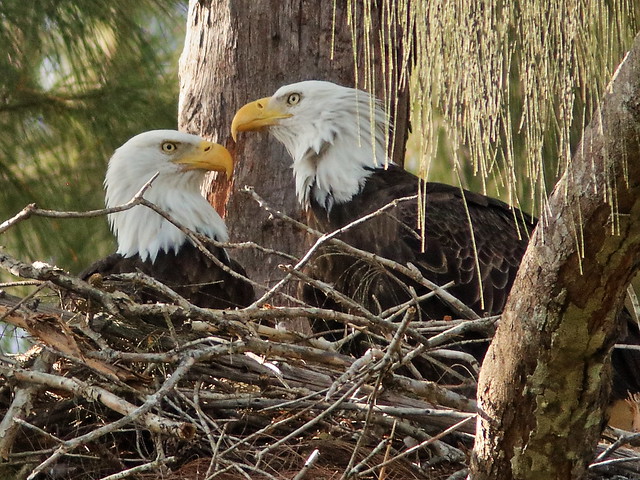

The nest on November 2:

Both members of the pair spent much time on the nest. (November 24). Jewel is on the left:

They copulated, this time on November 26:

Their first clutch was laid in late November and was expected to hatch in early January, 2020.
The pair exchanged incubation duties. Here, the male is waiting to replace Jewel who is about to fly off (December 7):

Jewel departs and turns over incubation duties:
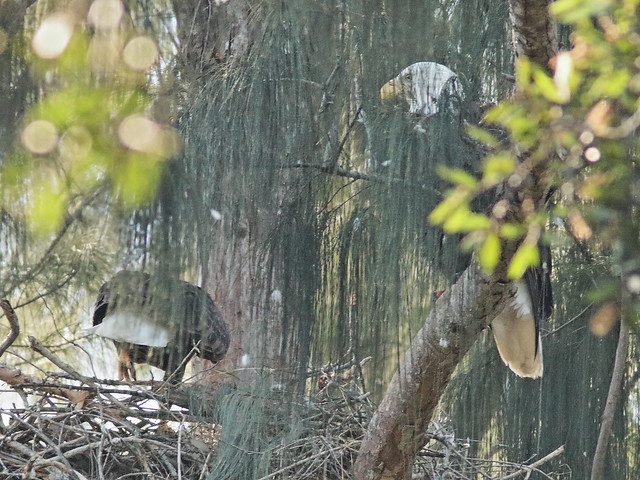
There was visual and photographic evidence of at least one eaglet being fed in the nest just before a storm on January 4. The storm was fierce and caused wind damage and at least one tornado. The next day some observers believed that the adult was feeding one or more eaglets, but there were no confirmed sightings. Another bad storm occurred on January 10.
In between the storms the adults were busy repairing the nest, which lost a considerable amount of its bulk, especially on the right (west) side. We presumed that the eaglet(s) and any unhatched eggs were lost between January 4th & 10th. Pride & Jewel repairing nest (January 11, 2020):

They repaired the nest and were seen copulating in late January. A second clutch of eggs was deposited in mid-February, and there was evidence that the first egg had hatched on or about March 14. Two eaglets hatched, the 24th and 25th eaglets known to have been produced in this nest since South Florida Audubon began monitoring the nest in 2007. The same male (Pride) has been present since then, and Joy was his first mate. She disappeared in October, 2014 and soon was replaced by Jewel, a young (4 year old) female.
Here are both eaglets on April 8, 2020, when they were about 3 1/2 weeks old. The younger male, standing high on the right, still has a tuft of natal down on his head:

This is the first-hatched eaglet (P Piney 24), presumably a female, on April 11. Bald Eagle eggs are deposited every 2-3 days and hatch asynchronously. Two out of every three first-hatched are females:

Female eaglets grow rapidly and are very competitive with nest-mates. If the second-hatched is also female, they will fight for dominance and often the younger bird either starves or may be killed by her sibling. A younger male will usually not challenge an older female, so this is the best combination for survival of both if food is abundant.
Both eaglets were loafing out on the branches on June 26, when they were about 15 weeks (105 days) old. The male, in the foreground has darker feathers than the female:

The darker plumage of the male is an individual variation, not linked to its gender, so far as I can determine:

Note the more massive head of the female. The large bill, more prominent "brow." and the greater extension of the gape (corner of beak) below her eye is characteristic of female Bald Eagles:

As is usually the case, the female was first to fledge, taking her first flight on May 21 at the age of 68 days. She disappeared until May 30. The male fledged on June 3 and returned to the nest the next day. They will come to the nest to be fed by the parents. The adults deposit prey into the nest to attract the eaglets, a practice which most efficiently allows them to feed and protect them in one location. For several weeks they will accompany the adults on foraging trips as they gain hunting skills.
Here is a Link to spreadsheet which tracks events at the nest over the past 11 breeding seasons:
http://www.rosyfinch.com/EagleMilestonesSheet.pdf
Research shows great variation in survival rates. The proliferation of Florida's eagle population suggests that conditions may be more favorable. However, when the eagles move into urban areas they are subject to new hazards, particularly motor vehicle collisions and injury from power lines. Aggression between eagles over territories and mates also may become more common where they compete for limited resources. Most mortality occurs within the first few months before the eaglets gain survival skills.
A spreadsheet (PDF) which details observations of this nest since 2008 may be accessed AT THIS LINK.
*In estimating the timing of the laying of eggs and hatching of the eaglets, we must depend upon clues from changes in the behavior of the adults. The onset of incubation coincides with the laying of the first egg, which is when we suddenly see one of the pair down deep and immobile in the nest. Hatching is a time of excitement, as the parents shift position frequently, peer down into the nest, and they start bringing in prey and tearing off bits to feed the tiny chick. The adults also sit a bit higher in the nest after the first egg hatches, supporting themselves on their wings to form a "tent" to shelter the chick and yet provide warmth to any eggs that have not yet hatched.
Volunteer nest observers share their sightings and photos, and respond to queries in the Pembroke Pines Eagle Nest Watch FORUM here, which includes a link to spreadsheets that document observations over the past three breeding seasons .

This comment has been removed by a blog administrator.
ReplyDeleteThank you so much for this diary. I have noticed recently that the nest appears to be abandoned. Hopefully that will change.
ReplyDeleteHi:
ReplyDeleteI live in Century Village in Pembroke Pines. While sitting on my proch, I saw a large brown bird that came to rest in the crest of a nearby tree. To my surprise, I immediately noticed that thid bird had a white head and knew right away, that it is a Bald Eagle. As a recently transplanted New York State resident, I have never seen one before and considered myself fortunate to see this one.